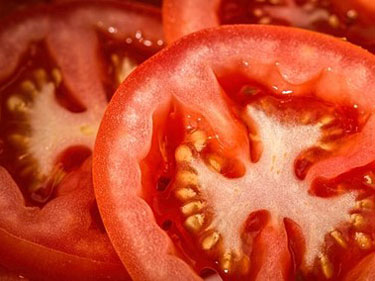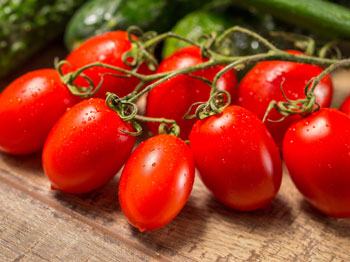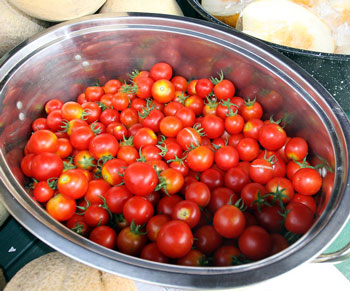Which Tomatoes Are Best for Canning?
Ever wonder which variety of tomato is the best for canning? Let's break it down for
you.
Searcy, Ark. –
 The canning of homegrown produce has been popular for many years. Tomatoes are the
most widely canned product in the United States and also one of the most commonly
spoiled products.
The canning of homegrown produce has been popular for many years. Tomatoes are the
most widely canned product in the United States and also one of the most commonly
spoiled products.
Let’s face it, almost everybody likes to see tomatoes on the table, in the garden or on the pantry shelf in a Ball or Mason jar.
After repeated requests and extensive research, I’ve assembled a list of some choices for the best tomatoes to use when canning. These days, they come in all the colors of the rainbow and every shape and size imaginable.
A lot of what makes those varieties so tasty is their juice, which is perfect to add moisture and flavor to a salad or sandwich but will add work and frustration in a canning kitchen.
There are not a lot of excellent canning heirlooms available for the home grower! So what’s a girl or guy to do?
How do you choose which tomato variety for canning?
Some of this depends on whether you intend to can whole tomatoes or tomato sauce.
Which tomatoes are best for canning sauce?
Low moisture is only important when canning tomato sauce and paste. Low moisture Roma-type tomatoes make the best sauce, but they come up lacking in flavor when canned as whole tomatoes. There are a number of big-name heirloom tomatoes that are ideal for canning whole tomatoes, diced tomatoes and tomato juice.
Considerations for Sauce Tomatoes: Taste, Low Moisture, Small Seed Cavities, High Yielding, Dependable Yields & Disease Resistance, 6. Ripening Timetable (spaced out over the season or all at once)
Considerations for Whole or Juice Tomatoes: Taste after processing, Firmness after processing (for whole tomatoes), Sized to Fit Jars (for whole tomatoes), High Yielding, Dependable Yields & Disease Resistance, Ripening Timetable (spaced out over the season or all at once)
What Are the Best Roma Tomato Varieties for Canning?
 Roma-type tomatoes have been selected to have small seed cavities and low moisture,
meaning that they require less cook time to create a thick sauce. Roma varieties also
tend to be high-yielding, and a tough but easily removable skin combined with low
moisture means that they’ll keep at room temperature for longer than most other varieties
of tomatoes, allowing you to accumulate your harvest for several weeks before canning.
All around, Roma-style tomatoes will produce the highest yield of sauce in the least
amount of time.
Roma-type tomatoes have been selected to have small seed cavities and low moisture,
meaning that they require less cook time to create a thick sauce. Roma varieties also
tend to be high-yielding, and a tough but easily removable skin combined with low
moisture means that they’ll keep at room temperature for longer than most other varieties
of tomatoes, allowing you to accumulate your harvest for several weeks before canning.
All around, Roma-style tomatoes will produce the highest yield of sauce in the least
amount of time.
If you’re looking to can tomato sauce in bulk or make your own tomato paste, Roma tomatoes are your best bet!
The best Roma tomatoes for canning include:
San Marzano – Known for their sweet flavor, dense flesh and small seed cavities, San Marzano tomatoes are a traditional Italian favorite. They’re especially low acid, so be sure to add some kind of acid such as balsamic vinegar or lemon juice to your sauce before canning (or pressure can the sauce). San Marzano are an excellent choice for sun-dried tomatoes.
Amish Paste – This thick-walled, meaty heirloom variety from Wisconsin produces flavorful 8 to 12-ounce fruits. Yields are high, and since it’s low moisture, much of that yield will come through in the final sauce. The problem is that this beauty hails from Wisconsin and I cannot find anyone who recommends it for Arkansas’ growing conditions.
Big Mama – A modern hybrid tomato that produces gigantic 5” long and up to 3” wide paste tomatoes that peel easily. It’s low moisture and small seed cavities mean heavy sauce yields plus it has a cool name!
Golden Mama – This hybrid tomato was bred for striking yellow flesh, as well as mild and sweet taste. It yields heavily, allowing you to make large batches of unique yellow sauce from just a few plants.
Viva Italia - This hybrid variety of the old-fashioned 'Roma' produces that same vigorous plants and uniform, meaty, red plum fruit, but they develop a few days faster with more disease resistance and larger, 4 to 8 oz. tomatoes.
Plum Dandy - Early maturing plant produces high yields of red plum-shaped tomatoes. They are firm, very sweet, and very flavorful. This is a quality paste and salad tomato that grows in clusters and is resistant to Early Blight. It’s an excellent choice for home gardens and market growers.
What Are the Best Beefsteak and Slicing Tomatoes for Canning?
Large slicing heirlooms and highly productive greenhouse hybrids tend to contain a high percentage of moisture, which will need to be cooked off before your sauce reaches the appropriate texture. They also tend to contain large seed cavities, which will need to be removed as seeds will make the final sauce bitter.
4 reasons to use beefsteak and slicing tomatoes for the sauce:
1. Price – When in peak season, local farms will practically give these away by the case lot. When the full harvest comes in, it’s usually dramatically more than local markets can absorb.
2. Availability – Cosmetically challenged fruits have little chance of selling, as consumers have their pick of the perfect specimens. Home canners can take advantage of this by contacting local farmers and buying them in lots as small as 20 pounds to as large as several hundred pounds for mere pennies on the dollar.
3. Taste – Certain heirlooms also impart distinctive flavors and colors to a sauce that cannot be accomplished with the low moisture Roma’s on the market today.
4. Color – Green zebra tomatoes can make a unique green sauce for example, and gold or orange variants can also make an especially dramatic presentation.
Here are some of the best beefsteak tomato varieties for canning:
- Ace 55 – These thick-walled tomatoes are about the size of a tennis ball and stay firm even when cooked, making them a perfect choice for canning whole. They’re low acid, so be sure to add plenty of lemon juice for water bath canning.
- Black Krim – This Russian heirloom produces large yields of unique blackish-purple tomatoes with a rich flavor. Plants grow very large, be prepared with extra supports. Note: sometimes it’s difficult to grow heirloom tomatoes in Arkansas with our climatic conditions.
- Marglobe – Developed by the USDA to be one of the first disease-resistant tomatoes in the early 1900’s and treasured as a home canning tomato ever since. Plants yield heavily, and the fruits ripen all at once, making them ideal for large batch canning. Plants are also known for making a particularly flavorful canned tomato juice.
- Rutgers Original Tomato – Flavorful, medium-sized 4 to 6-ounce fruits hold up well to canning. Originally bred from the Marglobe tomato.
What Are the Best Cherry Tomatoes for Canning?
 While cherry tomatoes may seem an odd choice for sauce, given that they’re tiny seed
bombs, and seeds in a sauce isn’t a good idea. However, they’re highly productive
and contain a high sugar content as well as a distinctive pleasant flavor. If you
have a food mill or chinois sieve that can readily separate out the skin and seeds,
trying out a small batch of cherry tomato sauce is worth it for novelty value alone.
While even a dozen high-yielding plants will not give you enough to make gallons at
a time, a few pints with the fresh sweet zing of a cherry tomato will liven up any
sauce. Since cherry tomatoes are especially hard to peel and seed, use a food strainer
to easily remove the peels and seeds from the pulp.
While cherry tomatoes may seem an odd choice for sauce, given that they’re tiny seed
bombs, and seeds in a sauce isn’t a good idea. However, they’re highly productive
and contain a high sugar content as well as a distinctive pleasant flavor. If you
have a food mill or chinois sieve that can readily separate out the skin and seeds,
trying out a small batch of cherry tomato sauce is worth it for novelty value alone.
While even a dozen high-yielding plants will not give you enough to make gallons at
a time, a few pints with the fresh sweet zing of a cherry tomato will liven up any
sauce. Since cherry tomatoes are especially hard to peel and seed, use a food strainer
to easily remove the peels and seeds from the pulp.
Here are some of the best cherry tomato varieties for canning:
- Supersweet 100 – Named for its huge clusters of fruit, with as many as 100 tomatoes on a single fruiting cluster. Extremely high yields mean that you’ll be able to collect enough tomatoes from a few plants to make a sauce.
- Sungold Cherry Tomato – Sungolds are exceptionally sweet, golden-orange tomatoes around one inch in size. The hearty, indeterminate plants start yielding early and bear right through the season, and are recommended for staking or caging as this cultivar has been known to grow to great heights. The sweet orange fruits make a distinctive sauce.
- Yellow Pear Cherry Tomato – This heirloom produces large crops of bright yellow, pear-shaped cherry tomatoes. They’re very low moisture for cherry tomatoes, making them ideal for a sauce. The “neck” of the pear is all flesh, and the seed cavities are relatively small. That means larger yields of flavorful yellow sauce.
- Juliet - Juliet bears delicious, sweet fruit on indeterminate vines. Some gardeners refer to it as a mini Roma because of the shape. The wonderfully sweet fruit are crack resistant and remain in good condition on the vine longer than most cherry tomatoes.
Hopefully, this list will give you something to think about if you grow your own or shop at roadside stands or farmer's markets.
If you need help preparing for the canning season check out this Self-Sufficient U blog post!
For the correct processing times and procedures for canning tomatoes consult the National Center for Home Food Preservation.
Visit our tomato gardening page for growing tips.
For more information you can contact your local county extension service, you can also follow Sherri Sanders @UAEX.WhiteCountyAgriculture on Facebook.
###
By Sherri Sanders
White County Extension Agent - ANR
U of A Division of Agriculture
Cooperative Extension Service
2400 Old Searcy Landing Road Searcy AR 72143
(501) 268-5394
ssanders@uada.edu